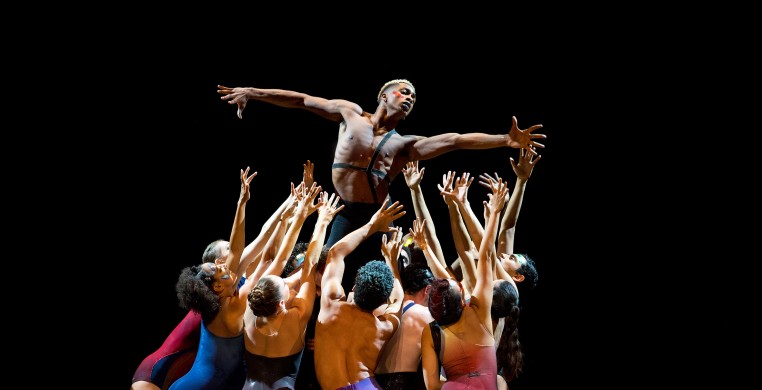Absent from Chicago since 2006, Complexions Contemporary Ballet (CCB) returns to present “Star Dust: From Bach To David Bowie” at the Auditorium Theatre at 7:30pm, February 3. The first half of the evening will present a sampling of excerpts from their 30-year-long histoy, including “Chaconne,” “Choke,” “Pocket Symphony,” “Elegy,” “Work It Out" and the critically acclaimed "Star Dust." Each piece has been chosen to reintroduce and highlight the diverse strengths of CCB and to share a common theme of classical composer Johann Sebastian Bach.
The main course of the evening is "Star Dust,” choreographed by CCB co-founder and co-artistic director Dwight Rhoden. The 40 minute performance spans David Bowie’s 40+ year career and pays homage to Bowie’s style and courageous spirit. While many popular hits such as “Changes,” “Heroes,” and “Modern Love” may be familiar to audiences, Rhoden also chose deep cuts from Bowie’s swan song album “Black Star” (2016).
Dancers are decorated in colorful, angularly-constructed costumes designed by Christine Darch, and are adorned with face paint, evoking the style and flair of Bowie’s alter ego Ziggy Stardust. Dancers shift into the role of portraying a Bowie-esque figure with each song, bringing their own individuality and flair to the embodiment of the singer. In an interview with Rhoden, he states that “there is a little bit of Bowie in all of us,” and through this work he celebrates that unifying spirit.
 Co-Founder, Co-Artistic Director, and Resident Choreographer Dwight Rhoden; Photo Courtesy of Complexions Contemporary Ballet
Co-Founder, Co-Artistic Director, and Resident Choreographer Dwight Rhoden; Photo Courtesy of Complexions Contemporary Ballet
In talking with Rhoden, the affection and respect that he has for Bowie is tremendous. He paints Bowie as “unapologetic, a pioneer; earnest but wild.” From a young age he has felt a deep connection to the artist and his pursuit of fracturing societal norms through his creative work. Rhoden describes “Star Dust” as both a “love letter and tribute,” and his hope for the audience is that they are inspired by “the beauty and brilliance” of both the man and the music.
The influence of Bowie on Rhoden is visible in his successful 30 year career with CCB. David Bowie was known for his breaking of convention and constant reinvention with each new album release. Through Rhoden’s leadership and choreography of over 80 ballets for CCB, not to mention his work for other dance companies, including Alvin Ailey American Dance Theater and New York City Ballet, he has embodied the same risk taking and adventurous spirit.
Bowie, often noted as the King of Glam Rock, continuously broke through cultural boundaries throughout his life. Whether stomping around in 6-inch-high platform boots, appearing as his alter ego Ziggy Stardust, or wearing androgynous and often geometrically styled clothing, he never let popular cultural standards impede his artistic ingenuity. He created a sanctuary through music for those who felt disregarded or ostracized by their communities, and his legend continues to live on.
 Complexions Contemporary Ballet ensemble in "Star Dust"; Photo by Sharen Bradford
Complexions Contemporary Ballet ensemble in "Star Dust"; Photo by Sharen Bradford
Complexions Contemporary Ballet has itself created a sanctuary for dancers over its 30 year history. Since its founding in 1994, Rhoden and co-artistic director Desmond Richardson have stayed true to their “singular approach to reinventing dance through a groundbreaking mix of methods, styles, and cultures.” They have also created learning opportunities through their CCB Academy and other educational offerings.
A nomadic company, CCB has no designated physical rehearsal or education space of its own, but has created a culture of artistic pursuit fueled by curiosity and accessibility for young dancers, working professionals, and audience members worldwide. Its commitment to diversity, inclusion, and variance in both their company members and catalog of works has helped to push the dance world past its limiting structures concerning body type, race, and socioeconomic status.
While Bowie’s artistic hammer knocked down walls in the music industry, Rhoden and Richardson have held steadfast through their long careers of confronting and dismantling the classical structures of ballet and concert dance. One of the most diverse ballet companies in the world, Rhoden and Richardson are committed to breaking the traditional values of classical ballet while still offering their audiences high entertainment value. Rhoden believes that within dance there is an accessibility factor, and that in order to build audiences there must be a willingness to meet them in their world.
Although Bowie was known for wild costumes and an eccentric personality, there was always an accessibility to his music, and he created something for people of all walks of life on each album. This shared accessibility between CCB and Bowie gives an entry point for observers to step into the counter cultural end of the swimming pool and experience a new perspective of what music, dance, and art can be.
Upon first glance, pairing music rooted in classical music with David Bowie might seem too much of a contrast for the audience to digest in one evening. When asked about the disparity between presenting Bach and Bowie on the same bill, Rhoden stated that it encompasses “the ethos of the company,” in which he observes “the diversity in music, textures, and types of movement and work. It really does come from those two extremes, from Bach which is very classical and Bowie which is multi-genre.” For a company that prides itself on removing boundaries and pushing the limits of concert dance, the presence of both Bach and Bowie in one night just makes sense.
“STAR DUST: From Bach To David Bowie” runs for one night only, Feb. 3, 7:30pm, at the Auditorium Theatre, 50 E. Ida B. Wells Drive. Tickets can be found by clicking on the event link below.

